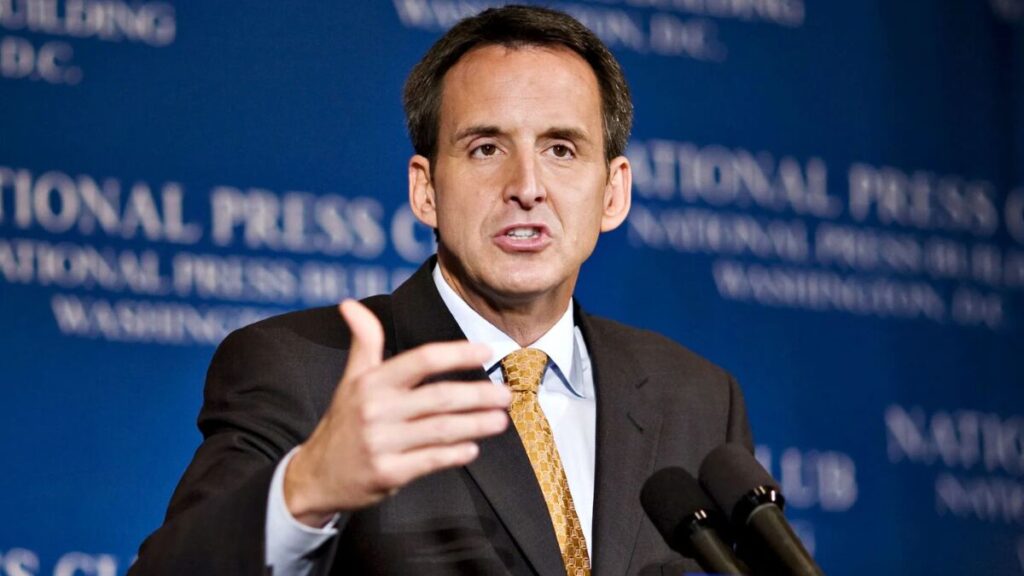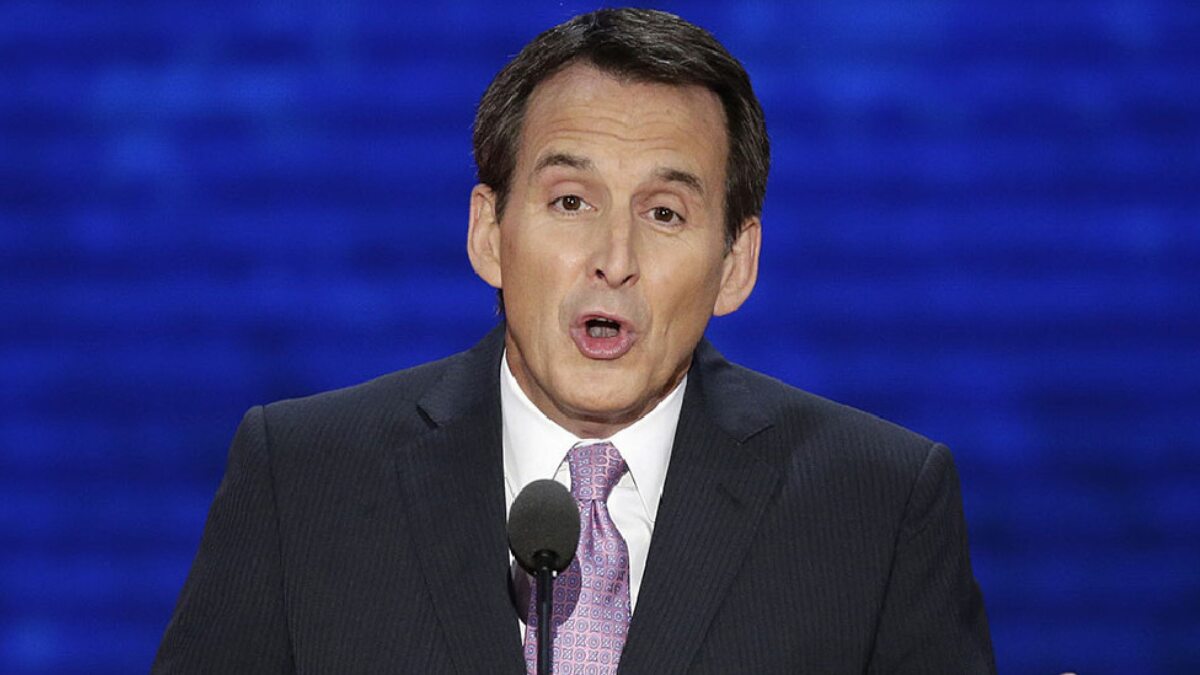From the governor’s mansion to corporate boardrooms, Tim Pawlenty’s rise to a $3 million fortune proves that political power can translate into serious financial gain.
Best known as the 39th Governor of Minnesota and a former presidential hopeful, Pawlenty, now in his mid-60s, has spent decades in the public eye shaping policy, leading national financial organizations, and quietly building wealth through strategic business moves.
In 2025, Tim Pawlenty’s net worth is estimated at around $3 million, a figure that reflects his successful shift from politics to the private sector. But how exactly did he grow his wealth after leaving office?
With renewed public interest following his ongoing roles in corporate America and past leadership at the Financial Services Roundtable, now is the perfect time to break down how he made his money.
In this article, we’ll explore Tim Pawlenty’s salary history, income streams, assets, business ventures, and key career milestones giving you a full picture of how he earned and maintains his wealth today.
Table of Contents
Tim Pawlenty’s Net Worth in 2025
As of 2025, Tim Pawlenty’s estimated net worth is $3 million, according to Celebrity Net Worth. His financial journey reflects a steady transition from public service to the private sector, where he leveraged his political experience into executive roles and board memberships. While not among the ultra-wealthy elite, Pawlenty’s net worth growth showcases a consistent and strategic approach to income generation over time.
Estimated Net Worth Over the Years
| Year | Estimated Net Worth | Key Developments |
| 2015 | $1.2 million | Post-governorship consulting and speaking |
| 2018 | $1.8 million | CEO of Financial Services Roundtable |
| 2020 | $2.3 million | Corporate board positions expand |
| 2023 | $2.7 million | Stock holdings increase in value |
| 2025 | $3 million | Stable assets, continued board roles |

Contributors to Tim Pawlenty’s Wealth
Public Sector Salary: As governor of Minnesota (2003–2011), Pawlenty earned a respectable salary and pension benefits.
Private Sector Leadership: His tenure as CEO of the Financial Services Roundtable significantly boosted his income through executive compensation and bonuses.
Corporate Boards & Stock Holdings: Pawlenty serves on boards such as Smart Sand Inc., where he holds stock valued at over $67,000 as of 2025. He also had ties to ConvergeOne Holdings Inc. and Digital River Inc.
Stock and Investment Holdings: Public SEC filings and reports from GuruFocus show steady growth through conservative investments and stock-based income.
How Tim Pawlenty Makes Money
Tim Pawlenty’s income has come from a combination of government salaries, private-sector leadership roles, board memberships, and long-term investments. While he isn’t known for flashy brand endorsements or media deals, his earnings reflect a steady, strategic approach to wealth-building.
Political Salaries
As the 39th Governor of Minnesota (2003–2011), Tim Pawlenty earned a publicly funded salary typical for state governors. During his time in office, the annual salary for the role was approximately $120,000 to $130,000. Over eight years, this totals close to $1 million in gross income from his time in public office.
Before becoming governor, he also served in the Minnesota House of Representatives, including as Majority Leader, which provided additional, though more modest, government income.

Endorsements and Public Engagements
Unlike many modern political figures, Pawlenty has not relied heavily on endorsements or celebrity-branded deals. There are no publicly documented major brand endorsements or paid sponsorships associated with his name as of 2025.
However, he has participated in paid speaking engagements and industry panels, particularly during and after his time leading the Financial Services Roundtable, which likely contributed supplemental income in the range of $10,000–$20,000 per event, based on typical market rates for former governors and policy leaders.
Business Deals and Board Memberships
After leaving public office, Pawlenty transitioned into the private sector with significant roles that became key contributors to his wealth.
CEO of the Financial Services Roundtable (2012–2018): This high-profile role placed him at the helm of a major financial industry lobbying group. While his exact salary wasn’t disclosed, comparable CEO positions in Washington D.C. trade organizations typically earn $500,000 to $1 million annually.
Board of Directors – Smart Sand Inc.: According to GuruFocus, as of early 2025, Pawlenty holds over 32,000 shares in Smart Sand Inc., with a market value of roughly $67,000. Director roles often include annual compensation packages ranging from $50,000 to $150,000, depending on company size and scope.
Other Business Roles: Pawlenty has also served with Digital River Inc. and ConvergeOne Holdings, adding to his compensation through cash stipends and equity grants, further solidifying his financial base.
Investments and Other Income Sources
Pawlenty’s investment strategy appears conservative and long-term, based on available SEC filings. He has reported holdings in publicly traded companies, including stock-based compensation tied to his board positions.
There is no evidence of ownership in major real estate ventures, luxury brands, or high-risk investment startups, suggesting a preference for steady income via dividends, board retainers, and stock appreciation.

Tim Pawlenty Career Timeline
Early Life & Education
1960 – Born on November 27 in Saint Paul, Minnesota.
1983 – Earned B.A. in Political Science from the University of Minnesota.
1986 – Received J.D. from the University of Minnesota Law School.
Early Political Career
1989–1992 – Appointed to Eagan Planning Commission; began engaging in local politics.
1993 – Elected to the Minnesota House of Representatives.
1999–2002 – Served as House Majority Leader, building influence within the Minnesota Republican Party.
Governor of Minnesota
2003 – Elected 39th Governor of Minnesota.
2006 – Re-elected for a second term.
2003–2011 – Earned approximately $120K–$130K/year as governor, totaling nearly $1 million in salary.
2008 – Considered as a potential Vice Presidential pick for John McCain.
2010 – Announced he would not seek a third term, fueling speculation about national ambitions.
Presidential Campaign & National Spotlight
2011 – Launched a campaign for the Republican presidential nomination.
2011 (Aug) – Withdrew from the race after the Iowa Straw Poll.
2012 – Again considered a possible VP candidate, this time for Mitt Romney.
Private Sector & Business Career
2012–2018 – Named President & CEO of the Financial Services Roundtable, a Washington-based banking industry advocacy group.
Likely earned $500K–$1M annually, a major contributor to his post-political wealth.
2015–2025 – Joined multiple corporate boards, including:
- Smart Sand Inc. – Held over 32,000 shares, valued at ~$67,000 in 2025.
- ConvergeOne Holdings
- Digital River Inc.
2018 – Briefly ran for Governor of Minnesota again but lost in the Republican primary.
Recent Years and Ongoing Roles
2020–2025 – Continued private sector involvement; remains active on boards.
2025 – Estimated net worth reaches $3 million, driven by steady income from board compensation, stock holdings, and accrued investments.
2025 – Maintains public presence through speaking engagements, conservative policy circles, and business advisory roles.

Tim Pawlenty’s Assets and Lifestyle
Unlike some public figures who flaunt extravagant wealth, Tim Pawlenty maintains a relatively low-profile lifestyle, with no widely reported indulgences in high-end luxury items or celebrity-level spending. However, over the years, he has acquired valuable assets and established a financially secure lifestyle consistent with his career in politics and corporate leadership.
Real Estate Holdings
While no exact property values are publicly documented, Pawlenty is known to reside in Eagan, Minnesota, a suburb of the Twin Cities. Homes in this area typically range from $400,000 to $800,000, suggesting a comfortable but modest residence compared to more lavish celebrity estates.
There is no public record of multiple properties or investment in high-end vacation homes, beachfront property, or penthouses, further emphasizing his more practical approach to wealth management.
Vehicles and Transportation
There is no public information indicating ownership of luxury vehicles, collectible cars, or private aircraft. Pawlenty has largely avoided the flashy trappings often associated with wealthy public figures. He is not known to travel via private jet, and most appearances suggest standard commercial travel arrangements.
Jewelry, Fashion, and Lifestyle Spending
Pawlenty keeps a conservative public image, favoring traditional suits and professional attire. He does not have a known association with designer fashion brands, luxury watches, or custom jewelry. His appearance and lifestyle reflect his Midwestern roots and a down-to-earth persona, aligning with his background in public service and policy.
Investment Assets
Rather than pouring wealth into high-end material goods, Pawlenty has focused on financial investments and board equity compensation. For example:
- Smart Sand Inc.: Owns over 32,000 shares valued at approximately $67,000.
- Additional investments likely include mutual funds, retirement accounts, and stock options tied to his board roles, offering consistent growth without media attention.
Unusual or Notable Purchases
There are no reported extravagant or unusual purchases tied to Pawlenty’s name. He has largely avoided the celebrity spotlight, opting instead for a private and disciplined financial approach.

Tim Pawlenty’s Personal Life
Tim Pawlenty was born on November 27, 1960, in Saint Paul, Minnesota, making him 64 years old in 2025. Raised in a working-class family in South St. Paul, Pawlenty is the son of a truck driver and grew up in a blue-collar household a background that has often shaped his political message and personal brand of fiscal conservatism and pragmatism.
Family and Relationships
Pawlenty is married to Mary Pawlenty, a former judge and First Lady of Minnesota during his governorship. The couple has two daughters, and they have maintained a relatively private and grounded family life. Mary’s own professional success and legal background further underscore the family’s focus on public service and professional achievement.
Their stable family dynamic has helped support Pawlenty’s long career in both politics and business, reinforcing his image as a disciplined, values-driven leader qualities often highlighted in his campaigns and public messaging.
Education and Early Ambitions
Pawlenty was the first in his family to graduate from college, earning a Bachelor’s degree in Political Science and later a Juris Doctor (J.D.) from the University of Minnesota Law School. His early interest in law and governance laid the foundation for his rise through Minnesota’s political ranks and later, his move into high-level business leadership.
Lifestyle and Philanthropy
Despite a multimillion-dollar net worth, Pawlenty maintains a modest, Midwestern lifestyle. He is not known for extravagant spending or luxury indulgences. Instead, he projects an image of discipline, fiscal responsibility, and grounded values traits that align with his financial habits and public persona.
Pawlenty has also been involved in Christian and faith-based initiatives, often citing religion as a guiding force in his life. Though not widely publicized, he has supported causes aligned with education, healthcare reform, and veterans’ affairs areas consistent with his policy interests while in office.
Fun Facts about Tim Pawlenty
Hockey Roots – Before politics, Pawlenty dreamed of being a professional hockey player and played on his high school team in South St. Paul.
From Law to Lobbying – After law school, he briefly worked as a labor lawyer before transitioning into politics, then later became CEO of a powerful financial lobbying group.
Rock & Roll Fan – He’s a big fan of classic rock, especially AC/DC, and once joked that his campaign walk-on song should be “Thunderstruck.”
Boardroom Regular – Pawlenty has sat on multiple corporate boards, quietly collecting stock-based income even after stepping away from the political spotlight.
Rejected Then Rebooted – After losing the 2012 GOP primary early, he didn’t slow down—he pivoted into business leadership and grew his net worth through strategic private-sector roles.
Net Worth Comparison Table
| Name | Profession | Net Worth (2025) | Comparison Notes |
|---|---|---|---|
| Tim Pawlenty | Former Governor, Business Executive | $3 million | Known for steady, modest wealth built through politics & board roles |
| Mitt Romney | U.S. Senator, Former Governor | $300 million | Earned fortune in private equity (Bain Capital) before politics |
| John Kasich | Former Governor, TV Host | $10 million | Boosted income post-politics with media gigs and consulting |
| Scott Walker | Former Governor of Wisconsin | $300 thousand | Lower profile after office, fewer corporate roles |
| Jeb Bush | Former Governor, Businessman | $40 million | Earned millions via consulting, board seats, and education investments |
FAQs
What is Tim Pawlenty’s net worth in 2025?
As of 2025, Tim Pawlenty’s net worth is estimated at $3 million, primarily earned through political roles, business leadership, and board memberships.
How did Tim Pawlenty make his money?
Pawlenty built his wealth through a combination of governor’s salary, CEO pay at the Financial Services Roundtable, and corporate board positions with companies like Smart Sand Inc. and ConvergeOne Holdings.
Does Tim Pawlenty own any luxury homes or real estate?
He is known to reside in Eagan, Minnesota, but there is no public record of multiple luxury properties or extravagant real estate holdings.
Is Tim Pawlenty married?
Yes, Tim Pawlenty is married to Mary Pawlenty, a former judge and First Lady of Minnesota. They have two daughters and maintain a private family life.
Does Tim Pawlenty have any major endorsements or brand deals?
No, Pawlenty has not been linked to any commercial endorsements or brand sponsorships, preferring a low-key professional image.
What are Tim Pawlenty’s biggest career income sources?
His top income sources include his governor salary (2003–2011), CEO compensation from his time at the Financial Services Roundtable, and stock-based income from board memberships.
Conclusion
Tim Pawlenty’s journey from a modest upbringing in Minnesota to a $3 million net worth in 2025 is a testament to steady leadership, career adaptability, and financial discipline. From serving as Governor to navigating the corporate world as a CEO and board member, Pawlenty has built a solid financial foundation without the flashiness often seen in public figures.
While he keeps a relatively low profile today, his ongoing roles in business and policy circles suggest he may continue to influence both sectors behind the scenes. Whether through more corporate leadership, advisory positions, or even public speaking, Tim Pawlenty’s professional path remains one to watch.
Explore more of our celebrity net worth profiles to see how others compare, from governors and senators to CEOs and media personalities.
Nishant is a digital strategist and celebrity finance expert with over 15 years of experience in SEO-driven content. As Founder of TheNetWorths.com, he crafts high-authority profiles on wealth, fame, and influence—trusted by readers seeking real insights behind public fortunes.

















